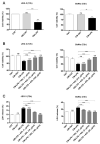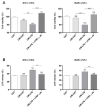Verbascoside-Rich Abeliophyllum distichum Nakai Leaf Extracts Prevent LPS-Induced Preterm Birth Through Inhibiting the Expression of Proinflammatory Cytokines from Macrophages and the Cell Death of Trophoblasts Induced by TNF-α
- PMID: 33036475
- PMCID: PMC7583932
- DOI: 10.3390/molecules25194579
Verbascoside-Rich Abeliophyllum distichum Nakai Leaf Extracts Prevent LPS-Induced Preterm Birth Through Inhibiting the Expression of Proinflammatory Cytokines from Macrophages and the Cell Death of Trophoblasts Induced by TNF-α
Abstract
Background: Preterm birth is a known leading cause of neonatal mortality and morbidity. The underlying causes of pregnancy-associated complications are numerous, but infection and inflammation are the essential high-risk factors. However, there are no safe and effective preventive drugs that can be applied to pregnant women. Objective: The objectives of the study were to investigate a natural product, Abeliophyllum distichum leaf (ADL) extract, to examine the possibility of preventing preterm birth caused by inflammation. Methods: We used a mouse preterm birth model by intraperitoneally injecting lipopolysaccharides (LPS). ELISA, Western blot, real-time PCR and immunofluorescence staining analyses were performed to confirm the anti-inflammatory efficacy and related mechanisms of the ADL extracts. Cytotoxicity and cell death were measured using Cell Counting Kit-8 (CCK-8) analysis and flow cytometer. Results: A daily administration of ADL extract significantly reduced preterm birth, fetal loss, and fetal growth restriction after an intraperitoneal injection of LPS in mice. The ADL extract prevented the LPS-induced expression of TNF-α in maternal serum and amniotic fluid and attenuated the LPS-induced upregulation of placental proinflammatory genes, including IL-1β, IL-6, IL-12p40, and TNF-α and the chemokine gene CXCL-1, CCL-2, CCL3, and CCL-4. LPS-treated THP-1 cell-conditioned medium accelerated trophoblast cell death, and TNF-α played an essential role in this effect. The ADL extract reduced LPS-treated THP-1 cell-conditioned medium-induced trophoblast cell death by inhibiting MAPKs and the NF-κB pathway in macrophages. ADL extract prevented exogenous TNF-α-induced increased trophoblast cell death and decreased cell viability. Conclusions: We have demonstrated that the inhibition of LPS-induced inflammation by ADL extract can prevent preterm birth, fetal loss, and fetal growth restriction.
Keywords: Abeliophyllum distichum Nakai; TNF-α; inflammation; macrophage; preterm birth; trophoblast.
Conflict of interest statement
The authors have declared no competing financial interests.
Figures








Similar articles
-
Folic acid protects against lipopolysaccharide-induced preterm delivery and intrauterine growth restriction through its anti-inflammatory effect in mice.PLoS One. 2013 Dec 6;8(12):e82713. doi: 10.1371/journal.pone.0082713. eCollection 2013. PLoS One. 2013. PMID: 24324824 Free PMC article.
-
Omega-3 polyunsaturated fatty acids reduce preterm labor by inhibiting trophoblast cathepsin S and inflammasome activation.Clin Sci (Lond). 2018 Oct 29;132(20):2221-2239. doi: 10.1042/CS20180796. Print 2018 Oct 31. Clin Sci (Lond). 2018. PMID: 30287519
-
Water extract of Artemisia scoparia Waldst. & Kitam suppresses LPS-induced cytokine production and NLRP3 inflammasome activation in macrophages and alleviates carrageenan-induced acute inflammation in mice.J Ethnopharmacol. 2021 Mar 25;268:113606. doi: 10.1016/j.jep.2020.113606. Epub 2020 Nov 23. J Ethnopharmacol. 2021. PMID: 33242622
-
Evaluation of the use of anti-TNF-alpha in an LPS-induced murine model.J Reprod Immunol. 2008 Jul;78(2):134-9. doi: 10.1016/j.jri.2007.11.003. Epub 2008 Apr 22. J Reprod Immunol. 2008. PMID: 18433878
-
Preterm birth, infection, and inflammation advances from the study of animal models.Reprod Sci. 2010 Jul;17(7):619-28. doi: 10.1177/1933719110373148. Reprod Sci. 2010. PMID: 20581349 Review.
Cited by
-
Development and validation of a transcriptomic signature-based model as the predictive, preventive, and personalized medical strategy for preterm birth within 7 days in threatened preterm labor women.EPMA J. 2022 Jan 18;13(1):87-106. doi: 10.1007/s13167-021-00268-9. eCollection 2022 Mar. EPMA J. 2022. PMID: 35273661 Free PMC article.
-
CCL2: An important cytokine in normal and pathological pregnancies: A review.Front Immunol. 2023 Jan 6;13:1053457. doi: 10.3389/fimmu.2022.1053457. eCollection 2022. Front Immunol. 2023. PMID: 36685497 Free PMC article. Review.
-
Ameliorative effect of Abeliophyllum distichum Nakai on benign prostatic hyperplasia in vitro and in vivo.Nutr Res Pract. 2022 Aug;16(4):419-434. doi: 10.4162/nrp.2022.16.4.419. Epub 2021 Oct 22. Nutr Res Pract. 2022. PMID: 35919286 Free PMC article.
-
Restriction of mitochondrial oxidation of glutamine or fatty acids enhances intracellular growth of Mycobacterium abscessus in macrophages.Virulence. 2025 Dec;16(1):2454323. doi: 10.1080/21505594.2025.2454323. Epub 2025 Jan 19. Virulence. 2025. PMID: 39828906 Free PMC article.
-
Anti-inflammatory effects of ethanolic extract from Abeliophyllum distichum (Miseon Tree) leaves in mice with dextran sulfate sodium-induced ulcerative colitis.Food Nutr Res. 2025 Jul 21;69. doi: 10.29219/fnr.v69.11052. eCollection 2025. Food Nutr Res. 2025. PMID: 40761499 Free PMC article.
References
-
- Born Too Soon: The Global Action Report on Preterm Birth. WTO; Geneve, Switzerland: 2012.
-
- Romero R., Roslansky P., Oyarzun E., Wan M., Emamian M., Novitsky T.J., Gould M.J., Hobbins J.C. Labor and infection: II. Bacterial endotoxin in amniotic fluid and its relationship to the onset of preterm labor. Am. J. Obstet. Gynecol. 1988;158:1044–1049. doi: 10.1016/0002-9378(88)90216-5. - DOI - PubMed
MeSH terms
Substances
Grants and funding
LinkOut - more resources
Full Text Sources

